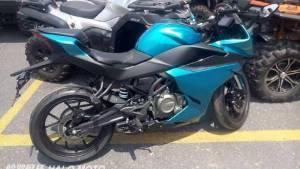Comparison test: CFmoto 650MT vs Suzuki V-Strom 650 XT
It wouldn't be wrong to say the middleweight adventure touring segment is the hottest premium one in the country now. In fact, no other premium segment has witnessed as many launches over the past year! Especially, the lower end of the segment that was dominated by the Kawasaki Versys 650 for the longest time. The Suzuki V-Strom 650 XT got launched last year though, followed by the Benelli TRK 502 earlier this year and the CFmoto 650MT now. Of course, the V-Strom has turned out to be the best package overall and also won our last comparison test against the Versys 650. So it only makes sense to pitch the Suzuki against the newest entrant, the CFmoto 650MT. The CFmoto's powertrain is based on the Kawasaki Versys 650's, which has always impressed us. And like the successful Versys 650, the 650MT is also a road-biased motorcycle. Interesting enough?
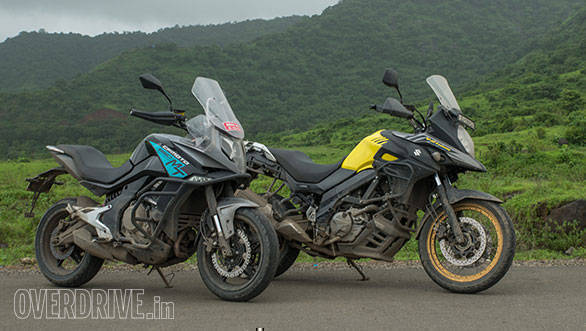 The CFmoto 650MT is the newest middleweight ADV on sale in India, while the Suzuki V-Strom 650 XT is current favourite, having won its last comparison test against the Kawasaki Versys 650. Can it repeat it feat? Or can the CFmoto dethrone the Suzuki?
The CFmoto 650MT is the newest middleweight ADV on sale in India, while the Suzuki V-Strom 650 XT is current favourite, having won its last comparison test against the Kawasaki Versys 650. Can it repeat it feat? Or can the CFmoto dethrone the Suzuki?
Design and engineering
While the V-Strom has a more traditional stance with its beak-like nose, the 650MT looks modern and futuristic. The Suzuki has a more universal appeal, while the CFmoto's looks are polarising especially the face with its vertically stacked headlights and overall fairing design. But more importantly the V-Strom is instantly identifiable as the bigger, more purpose-built machine. The 650MT is shorter in length and height, narrower and has a shorter wheelbase, making it smaller overall. This makes the 650MT more welcoming for shorter or inexperienced riders, but at the same time it lacks the Suzuki's big bike appeal that a lot of buyers graduating from smaller machines look for. The 650MT gets a height-adjustable windscreen which the V-Strom doesn't. You can adjust the 650MT's screen manually via adjustors positioned on either side of the instrument console, but the quality of its aluminium stalks and their locking mechanism is subpar.
 The Suzuki V-Strom 650 XT is larger than the CFmoto 650MT as far as physical dimensions are concerned, besides looking more like a proper adventure tourer as compared to the CFmoto, which looks more like a faired streetbike on stilts
The Suzuki V-Strom 650 XT is larger than the CFmoto 650MT as far as physical dimensions are concerned, besides looking more like a proper adventure tourer as compared to the CFmoto, which looks more like a faired streetbike on stilts
In fact, the system was already rattling on our test bike and CFmoto needs to improve the quality a lot. The Suzuki screen even though fixed, feels far superior in terms of quality. Same goes for the V-Strom's semi-digital instrument cluster which boasts much better quality while also being more legible. The 650MT's all-digital display does not look as well finished, as the finish of the silver plastic for its housing is tacky. The display itself is not very legible, especially the speedometer, which is a readout positioned inside the tachometer. Overall build quality of the V-Strom 650 is significantly better too, while the 650MT leaves a lot to be desired be in terms of fit-finish levels, panel gaps, weld finishes or plastic quality. The fairing and engine guard on the 650MT looks a little too large as well and the design could have certainly been better.
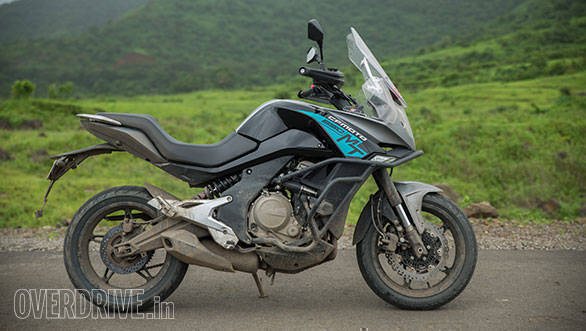 To its advantage, the CFmoto 650MT's more compact dimensions as compared to the Suzuki V-Strom 650 XT mean the CFmoto is easier and friendlier for inexperienced riders to swing a leg over
To its advantage, the CFmoto 650MT's more compact dimensions as compared to the Suzuki V-Strom 650 XT mean the CFmoto is easier and friendlier for inexperienced riders to swing a leg over
Rider aids
Both motorcycles are equipped with dual-channel ABS, though the Suzuki also offers the safety net of traction control additionally. You can choose from two levels, or switch TC off completely. The 650MT misses out on TC which is glaring in my opinion, though it does get two riding modes â" Sport and Touring â" which the Suzuki does not.
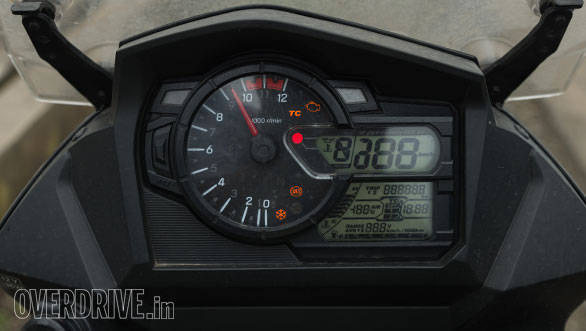 The Suzuki V-Strom 650 XT offers a better safety net as compared to the CFmoto 650MT, as the Suzuki comes equipped with traction control, which is more important than the riding modes the CFmoto gets
The Suzuki V-Strom 650 XT offers a better safety net as compared to the CFmoto 650MT, as the Suzuki comes equipped with traction control, which is more important than the riding modes the CFmoto gets
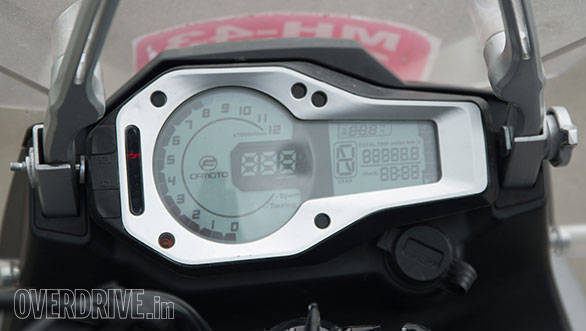 The layout and quality of plastics used on the instrument cluster of the CFmoto 650MT could have been better
The layout and quality of plastics used on the instrument cluster of the CFmoto 650MT could have been better
Ergonomics
Being the shorter and smaller motorcycle, the CFmoto 650MT offers an easier reach to its handlebar and seating is a little more upright too. The Suzuki requires you to lean forward ever so slightly and is thus sportier but as comfortable if not better. At 835mm, the V-Strom's seat height is also 5mm lower, though that isn't a big difference and the 650MT is just about as easy when it comes to putting both feet down.
Engines and performance
Ah, the most interesting part! The CFmoto uses a 650cc, parallel-twin, liquid-cooled engine copied from the Kawasaki Versys 650's motor, down to identical bore and stroke values. Its outputs are a smidgen higher at 71PS and 62Nm though, which, incidentally is identical to the V-Strom's outputs. In comparison the V-Strom engine is a liquid-cooled, V-twin motor displacing 645cc. Expectedly, the 650MT's parallel-twin feels peakier than the V-Strom's Vee, which feels a lot more linear, though I have to say the 650MT's engine also boasts ample bottom-end and midrange grunt. The V-Strom is the slightly quicker bike though, posting a 0-100kmph time of 5.08s as compared to the 650MT's 5.45 seconds.
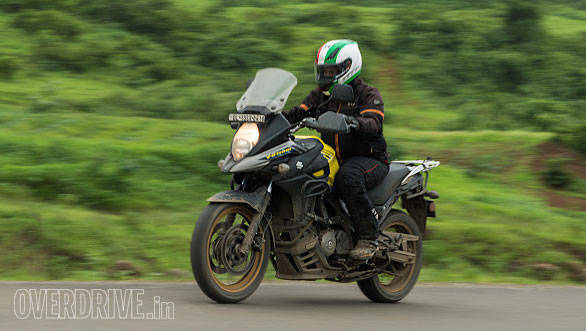 Its V-twin engine and more linear power delivery allow the Suzuki V-Strom 650 XT to accelerate quicker than the CFmoto 650MT
Its V-twin engine and more linear power delivery allow the Suzuki V-Strom 650 XT to accelerate quicker than the CFmoto 650MT
The gaps narrows down slightly when it comes to 30-70kmph and 40-80kmph roll-on acceleration timings in third and fourth gear respectively, but the Suzuki is still quicker by a whisker. Gear ratios on both bikes feel similar and are well-spaced, suiting city and highway rideability well without the need for too many gear changes. But there's a difference in the feel offered by both transmissions. Both offer precise shifts but the Suzuki gearbox feels slicker and easier to operate, while the CFmoto unit calls for more effort. The Suzuki engine also feels smoother, especially at higher revs. The CFmoto engine feels refined, but about half a notch lesser. It also starts feeling buzzy at high revs, unlike the Suzuki engine which feels as smooth.
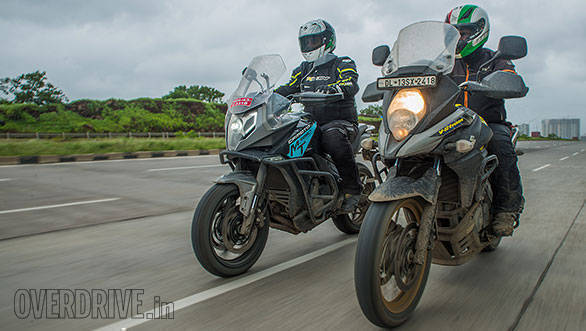 The CFmoto 650MT's power delivery is peakier than the Suzuki V-Strom 650 XT's. In fact, the CFmoto parallel-twin engine is based on the parallel-twin engine powering the Kawasaki Versys 650 - the CFmoto thus impresses with its performance, but the Suzuki simply feels more effortless in comparison when cruising on open roads
The CFmoto 650MT's power delivery is peakier than the Suzuki V-Strom 650 XT's. In fact, the CFmoto parallel-twin engine is based on the parallel-twin engine powering the Kawasaki Versys 650 - the CFmoto thus impresses with its performance, but the Suzuki simply feels more effortless in comparison when cruising on open roads
Ride and handling
Cycle parts on both motorcycles are interesting. The 650MT clears the air about being the more road-biased machine with its fat, upside down forks, offset monoshock (exactly like the Versys 650!) and 120-section front tyre. For the record, a 120-section front tyre is what you find on litre-class sport nakeds and superbikes! The Metzeler Roadtec rubber further clarifies the bike's intent as a tourer rather than a versatile on- and off-road machine, which is what the V-Strom 650 is. The Suzuki's front forks have the 'right side up' and the front wheel is a 19 inch one while the rear is a 17 inch unit. The Suzuki wears Bridgestone Adventure rubber, but more importantly it is the only motorcycle in its segment to sport wire-spoked wheels with tubeless tyres.
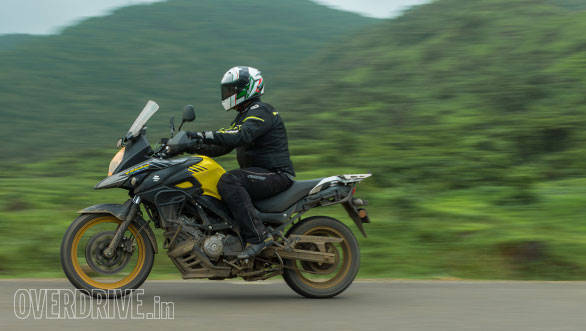 The Suzuki V-Strom 650 XT uses a 19-inch front wheel, besides the fact that it runs on wire-spoked wheels shod with tubeless tyres at both ends. These are significant advantages for the Suzuki over the CFmoto 650MT when it comes to riding on bad roads or treading off road
The Suzuki V-Strom 650 XT uses a 19-inch front wheel, besides the fact that it runs on wire-spoked wheels shod with tubeless tyres at both ends. These are significant advantages for the Suzuki over the CFmoto 650MT when it comes to riding on bad roads or treading off road
The wire-spoked wheels are a huge advantage and make for commendable off-road ability along with the dual sport tyres, unlike the CFmoto which essentially is a road bike with raised suspension and offers very little off-road ability. The bigger front wheel allows the Suzuki to tread off tarmac confidently in conjunction with the wire-spoked wheels. On the same note, the V-Strom 650 XT picked up a puncture when Anis and I were riding and the tubeless tyres on wire-spoked wheels combination proved to be life-saving! The tyre did not lose air instantly being a tubeless one and I was able to ride the bike for over 20km before finding a repair shop on the highway.
What's more, the V-Strom having a mainstand was another boon, as it offered the convenience of getting the puncture fixed without needing to hoist the bike manually while weighing it down on the side stand. Big brownie points for the Suzuki there as an adventure tourer! Coming to the handling bit, the CFmoto impresses on tarmac. The suspension setup is firm and offers good confidence at speeds, of course with aid from the Metzelers, but the V-Strom feels as confident if not better. Of course the fatter, smaller and grippier front tyre on the CFmoto makes it a better corner carver and it feels closer to a streetbike, though the V-Strom is almost up there with it. Overall ride quality on the Suzuki is better, as the CFmoto's firmer setup transfers some shocks to the riders when riding on bad roads.
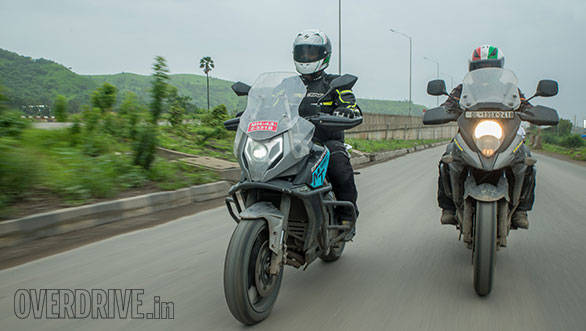 The CFmoto 650MT is shod with 17 inch Metzeler Roadtec tyres at both ends, which along with the bike's firm suspension setup give it an edge over the Suzuki V-Strom 650 XT in terms of handling on tarmac
The CFmoto 650MT is shod with 17 inch Metzeler Roadtec tyres at both ends, which along with the bike's firm suspension setup give it an edge over the Suzuki V-Strom 650 XT in terms of handling on tarmac
The V-Strom is also more adept at soaking undulated highways at speeds, offering greater comfort. Of course, the Suzuki can also tread off tarmac as its 19 inch front wheel lets it dig into the tricky stuff and offer a confident feel. It isn't up there with bigger middleweight ADVs like the Triumph Tiger 800 for instance in terms of off-roading, but allows you to tread off asphalt should you wish to. The CFmoto is a strict no-no for off-roading though and isn't very confidence inspiring even on broken roads, besides the fact that you could damage the alloy wheels if nothing else. All said and done, the V-Strom is the better package, offering a blend of on- and off-road ability along with a slightly better ride and better convenience.
Verdict
It's easy to see how much more expensive the Suzuki is, priced at Rs 7.46 lakh ex-showroom, as compared to the CFmoto's sticker price of Rs 4.99 lakh ex. But in the case of the Suzuki you truly get what you pay for â" a proper adventure tourer that's well-equipped with the right bits, is comfortable on the road and is willing tread off it too. Its build quality is as Japanese as it gets and of course there's no two ways about Suzuki being a two-wheeler maker of one of the highest reputes. The CFmoto is a road-biased tourer only, thereby by limiting its access to the adventure tourer badge, if there were one.
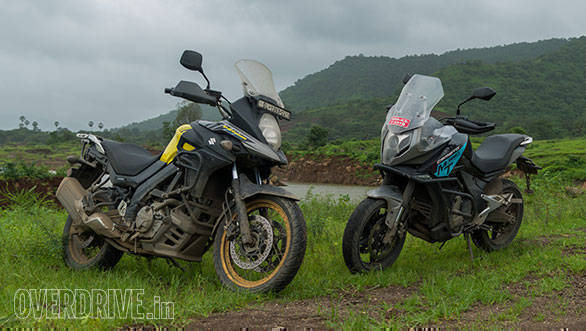 The CFmoto 650MT tried hard and even impresses on several front as a road-biased middleweight adventure touring motorcycle, but the Suzuki is simply the better motorcycle of the two, being a better package overall
The CFmoto 650MT tried hard and even impresses on several front as a road-biased middleweight adventure touring motorcycle, but the Suzuki is simply the better motorcycle of the two, being a better package overall
It is impressive as a highway tool, an everyday machine and is a confident handler too. Where it does not impress, is the build quality. CFmoto is also a new brand and one that is yet to establish itself in the good books of enthusiasts, unlike Suzuki. The Chinese manufacturer is also yet to build a strong dealer network and consequently a well-mapped aftersales service network. These are more important than the build quality or performance and dynamics of the motorcycle itself, which holds us back from giving the motorcycle a good overall score despite it impressing on several parameters. Clearly, the Suzuki V-Strom 650 XT is the winner here and the one to put your money on.
Photography: Gaurav Bose
Also see:
Our video comparison test of the CFmoto 650MT and the Suzuki V-Strom 650 XT
Suzuki V-Strom 650 XT vs Kawasaki Versys 650 Video
Starts Rs 4,99,000
649cc
6-Speed
70.70
62.00
-NA-


